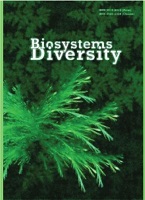Sensitivity of non-target groups of invertebrates to cypermethrin
Sensitivity of non-target groups of invertebrates to cypermethrin
Author(s): L. I. Faly, V. V. Brygadyrenko, A. Orzekauskaite, A. PaulauskasSubject(s): Health and medicine and law, Environmental interactions
Published by: Дніпропетровський національний університет імені Олеся Гончара
Keywords: : non-target groups of invertebrates; pyrethiroids; susceptibility to insecticide; median lethal dose; survivability of species;
Summary/Abstract: Agrogenic pollution with pyrethroid insecticides has been impacting the structure of populations of terrestrial invertebrates, causing decline in their taxonomic diversity and tolerance to critical values of environmental factors. In a laboratory experiment, we evaluated the sensitivity of 46 non-target invertebrate species to cypermethrin. In most examined species, we observed correlation between the body parameters (length and weight of body) and tolerance to this insecticide. We determined that the greater body size of the invertebrates, the better their tolerance to cypermethrin. Differences in LD50were the highest for groups of invertebrates with the body weight of 1.0–3.9 mg (1.9 ± 0.5 g/ha) and 16.0–63.9 mg (16.4 ± 3.2 g/ha). We observed a relashionship between the trophic specialization and sensitivity to the insecticide in phytophages and zoophages. Average LD50 values for phytophages were 2.1 ± 0.5 g/ha, much lower than for zoophages – 15.6 ± 3.3 g/ha. Among zoophages, the greatest tolerance to cypermethrin was demonstrated by ground beetles Carabus coriaceus L., Pterostichus niger (Schall.), P. melanarius (Ill.), Pseudoophonus rufipes (De Geer), and earwigs Forficula auricularia L. Analysis of various taxonomic groups of insects revealed the parameter to be 24.00 ± 4.66 for Carabidae, 8.60 ± 2.72 for Formicidae, and 0.23 ± 0.08 for Staphylinidae. Among the taxonomic groups we studied, the most sensitive to cypermethrin (LD50 = 0.002–0.99 g/ha) were Philonthus decorus(0.0029), Ph.rectangulus(0.0035), Ophonus rufibarbis(0.121), Oxytelus sculptus(0.124), Myrmica ruginodis(0.39), Aleochara lanuginosa (0.49), Carabus granulatus(0.51), Oxythyrea funesta (0.52), Tachinus signatus(0.55), Cixiidae sp. (0.56), Lygus pratensis (0.56), Carabus convexus (0.71), and C. hortensis (0.83). Lower sensitivity to cypermethrin (LD50 = 1.00–9.99 g/ha) was seen in Lasius fuliginosus (1.05), Pyrrhocoris apterus (1.28), Chortippus sp. 2 (1.96), Rhyparochromus phoeniceus (2.24), Phosphuga atrata (2.25), Chironomus plumosus(2.58), Labia minor(2.86), Graphosoma italicum (2.86), Hister fenestus (3.39), Cylindroiulus truncorum (3.61), Opilio saxatilis (3.71), Chortippus sp. 1 (3.94), Epaphius secalis (4.54), Lasius niger (4.77), Silpha carinata (4.84), Aphodius foetens(4.94), Porcellio laevis(5.68), Coreus marginatus(6.50), Leistus ferrugineus(7.39), and Lasius alienus(9.73). The most tolerant to cypermethrin (LD50 = 10.00–108.00 g/ha) were Calathus fuscipes(12.14), Limodromus assimilis(12.22), Trochosa terricola (12.55), Lithobius forficatus(13.98), Calathus ambiguus(20.85), Nebria brevicollis(23.20), Ponera coarctata (27.04), Megaphyllum sp. (29.01), Pseudoophonus rufipes(41.75), Pterostichus melanarius(45.78), P. niger(58.29), Forficula auricularia (80.57), and Carabus coriaceus (107.71). The differences we found in tolerance to cypermethrin ranged 100,000 times. This evidences the necessity of further research of taxonomic differences in tolerance of invertebrates to cypermethrin.
Journal: Biosystems Diversity
- Issue Year: 31/2023
- Issue No: 3
- Page Range: 393-400
- Page Count: 8
- Language: English

